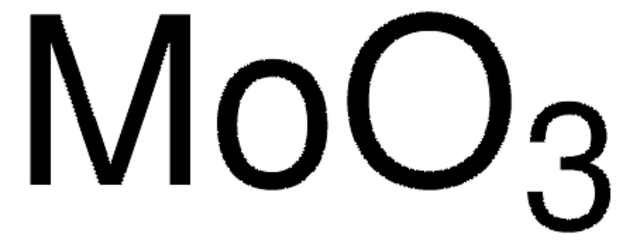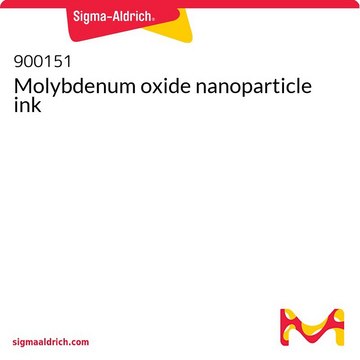M0753
Molybdenum(VI) oxide
ReagentPlus®, ≥99.5%
Sinonimo/i:
Molybdenum trioxide
Autenticatiper visualizzare i prezzi riservati alla tua organizzazione & contrattuali
About This Item
Formula condensata:
MoO3
Numero CAS:
Peso molecolare:
143.94
Numero CE:
Numero MDL:
Codice UNSPSC:
12352303
ID PubChem:
NACRES:
NA.55
Saggio:
≥99.5%
Stato:
crystals
Prodotti consigliati
Livello qualitativo
Nome Commerciale
ReagentPlus®
Saggio
≥99.5%
Stato
crystals
Impiego in reazioni chimiche
reagent type: catalyst
core: molybdenum
Punto di fusione
795 °C (lit.)
Cationi in tracce
NH4+: ≤0.02%
Stringa SMILE
O=[Mo](=O)=O
InChI
1S/Mo.3O
JKQOBWVOAYFWKG-UHFFFAOYSA-N
Cerchi prodotti simili? Visita Guida al confronto tra prodotti
Applicazioni
Precursor to LAMOX fast ion conductors and superconductors.
Used in the solid state synthesis of a remarkable ternary, reduced molybdenum oxide, Pr4Mo9O18, whose structure contains previously unknown Mo7, Mo13 and Mo19 clusters. The new cluster product is a small band gap semiconductor.
Note legali
ReagentPlus is a registered trademark of Merck KGaA, Darmstadt, Germany
Avvertenze
Warning
Indicazioni di pericolo
Consigli di prudenza
Classi di pericolo
Carc. 2 - Eye Irrit. 2 - STOT SE 3
Organi bersaglio
Respiratory system
Codice della classe di stoccaggio
11 - Combustible Solids
Classe di pericolosità dell'acqua (WGK)
WGK 1
Punto d’infiammabilità (°F)
Not applicable
Punto d’infiammabilità (°C)
Not applicable
Scegli una delle versioni più recenti:
Possiedi già questo prodotto?
I documenti relativi ai prodotti acquistati recentemente sono disponibili nell’Archivio dei documenti.
I clienti hanno visto anche
Patrick R Brown et al.
Nano letters, 11(7), 2955-2961 (2011-06-15)
The ability to engineer interfacial energy offsets in photovoltaic devices is one of the keys to their optimization. Here, we demonstrate that improvements in power conversion efficiency may be attained for ZnO/PbS heterojunction quantum dot photovoltaics through the incorporation of
Seiichiro Murase et al.
Advanced materials (Deerfield Beach, Fla.), 24(18), 2459-2462 (2012-04-11)
An MoO(3) film spin-coated from a solution prepared by an extremely facile and cost-effective synthetic method is introduced as an anode buffer layer of bulk-heterojunction polymer photovoltaic devices. The device efficiency using the MoO(3) anode buffer layer is comparable to
Design of transparent anodes for resonant cavity enhanced light harvesting in organic solar cells.
Nicholas P Sergeant et al.
Advanced materials (Deerfield Beach, Fla.), 24(6), 728-732 (2012-01-04)
Claudio Girotto et al.
ACS applied materials & interfaces, 3(9), 3244-3247 (2011-08-13)
We report on a sol-gel-based technique to fabricate MoO(3) thin films as a hole-injection layer for solution-processed or thermally evaporated organic solar cells. The solution-processed MoO(3) (sMoO(3)) films are demonstrated to have equal performance to hole-injection layers composed of either
Yu-Zhan Wang et al.
The Journal of chemical physics, 134(3), 034706-034706 (2011-01-26)
The electronic structures at the MoO(3)∕Co interface were investigated using synchrotron-based ultraviolet and x-ray photoelectron spectroscopy. It was found that interfacial chemical reactions lead to the reduction of Mo oxidation states and the formation of Co-O bonds. These interfacial chemical
Il team dei nostri ricercatori vanta grande esperienza in tutte le aree della ricerca quali Life Science, scienza dei materiali, sintesi chimica, cromatografia, discipline analitiche, ecc..
Contatta l'Assistenza Tecnica.
















